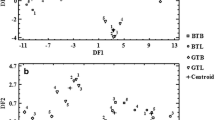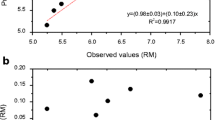Abstract
Multivariate optimization was employed to obtain the best conditions of the inductively coupled optical emission spectrometer (ICP OES) (nebulization gas flow rate of 0.47 L min−1 and applied power of 1.36 kW) for the determination of Al, Ba, Ca, Cu, Fe, K, Mg, Na, and Mn in 27 green tea samples. In the hierarchical cluster analysis, it was possible to observe the formation of five different groups (imported Japanese samples, samples without specifications, organically cultivated samples, samples in capsules, and ready-to-drink iced tea samples) besides the separation according to brand. In the principal component analysis we verified that the first four main components explained 99.98 % of the total variance. The ICP OES technique and the exploratory analysis were shown effective tools that can be used jointly in the quality control and classification of green tea samples.



Similar content being viewed by others
References
ANVISA, RDC no. 154, Brasil (2004) Legislação em Vigilância Sanitária, Resolução -RDC no. 154, de 15 de junho de 2004
Environmental Protection Agency–EPA (1992) Guidance for methods development and methods validation for the RCRA program SW-846 Methods
FDA no. 2004N- 0416, USA (2005) Department of health and human services, Rules and Regulations, Federal Register: June 9, 2005, 70, 110
Fernández PL, Pablos F, Martín MJ, González AG (2002) Food Chem 76:483–489
Flandrin JL, Montanari M (1998) História da alimentação, 2nd edn. vol 1. Estação Liberdade, São Paulo, p 885
Fujiki H, Imai K, Nakachi K, Shimizu M, Moriwaki H, Suganuma M (2012) J Cancer Res Clin Oncol 138(8):1259–1270
Gómez MR, Cerutti S, Sombra LL, Silva MF, Martinez LD (2007) Food Chem Toxicol 45(6):1060–1064
Green JM (1996) Anal Chem 305A–309A
Herrador MA, Gonzáles AG (2001) Talanta 53:1249–1257
Hussain I, Khan F, Iqbal Y, Khalil SJ (2006) J Chem Soc Pak 28(3):246–251
Li F, Li S, Li HB, Deng GF, Ling WH, Xu XR (2013) Food Funct 4(4):530–538
Lozak A, Soltyk K, Ostapczuk P, Fijalek Z (2002) Sci Total Environ 289:33–40
Marchisio PF, Sales A, Cerutti S, Marchevski E, Martinez LD (2005) J Hazard Mater 124:113–118
Massart DL, Vandeginste BGM, Buydens LMC, De Jong S, Lewin PJ, Smeyers-Verbeke J (1998) Handbook of Chemometrics and Qualimetrics: Part B. Elsevier, Amsterdam
Mingoti SA (2005) Análise de componente principais. Análise de dados através de métodos de estatística multivariada: uma abordagem aplicada, 1st edn. vol. 1, (pp 59–95). UFMG, Belo Horizonte p 59–95
Piñero AM, Fishen A, Hill SJ (2003) J Food Comp Anal 16:195–211
Powell JJ, Burden TJ, Thompson RPH (1998) Analyst 123:1721–1724
Silva JCJ, Santos DM, Baccan N, Cadore S, Nóbrega JA (2004) Microchem J 77:185
Souza PP, Siebaldi HGL, Augusti DV, Neto WB, Amorim VM, Catharino RR, Eberlin MN, Augusti R (2007) J Agric Food Chem 55:2094–2102
Statsoft (1999) Statistica for Windows, Computer Program Manual, Tulsa
Street R, Szakova J, Drabek O, Mladkova L (2006) Czech J Food Sci 24(2):62–71
Teófilo RF, Ferreira MM (2006) Quimiometria II: planilhas eletrônicas para cálculos de planejamentos experimentais, um tutorial. Quim Nova 29:338
Wise BM, Gallagher NB, Bro R, Shaver JM, Windig W, Koch RS (2005) PLS Toolbox 3.5 for use with MATLAB. Eigenvector Research Inc, Manson
Acknowledgments
The authors wish to thank the Ezequiel Dias Foundation (FUNED) for their donation of laboratory equipment for this research, the Coordenação de Aperfeiçoamento de Pessoal de Nível Superior (CAPES, Brazil), Conselho Nacional de Desenvolvimento Científico e Tecnológico (CNPq), and the Fundação de Desenvolvimento da Pesquisa (FUNDEP) for their financial support.
Conflict of Interest
Roberta E.S. Froes declares that she has no conflict of interest. Waldomiro Borges Neto declares that he has no conflict of interest. Mark A. Beinner declares that he has no conflict of interest. Clésia C. Nascentes declares that she has no conflict of interest. José Bento B. da Silva declares that he has no conflict of interest. This article does not contain any studies with human or animal subjects.
Author information
Authors and Affiliations
Corresponding author
Rights and permissions
About this article
Cite this article
Froes, R.E.S., Borges Neto, W., Beinner, M.A. et al. Determination of Inorganic Elements in Teas Using Inductively Coupled Plasma Optical Emission Spectrometry and Classification with Exploratory Analysis. Food Anal. Methods 7, 540–546 (2014). https://doi.org/10.1007/s12161-013-9651-3
Received:
Accepted:
Published:
Issue Date:
DOI: https://doi.org/10.1007/s12161-013-9651-3




